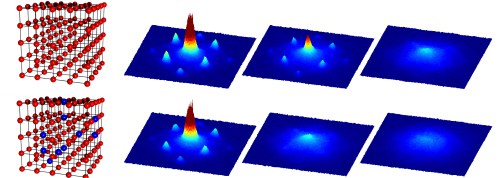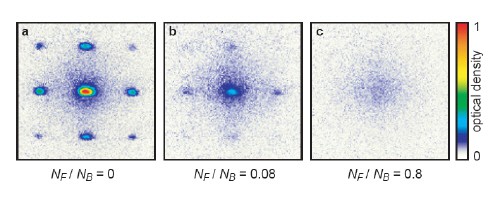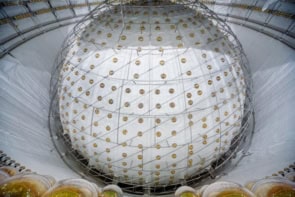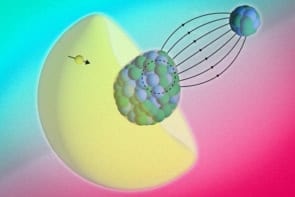Condensed matter physicists have come a step closer to their dream laboratory, with the news that two independent teams have managed to trap bosons and fermions together in a 3D optical lattice. The breakthrough provides a model system in which to study real-life solid-state materials, and may even lead to a better understanding of certain biological systems and traffic flow.
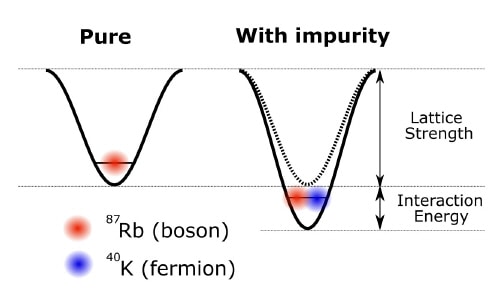
All atoms are either fermions or bosons depending on their spin angular momentum, and the difference between the two becomes clear when they are cooled to near absolute zero. Fermions obey the exclusion principle, which means that no more than two of them can occupy the same quantum state, but Bosons suffer no such restrictions. As such, they can collapse into the same quantum ground state in a process called Bose–Einstein condensation. By joining up into pairs, however, fermions can also form such a condensate — as electrons in a metal do to form a superconductor.
Since the first condensate was created in 1995, these states have allowed quantum phenomena to be studied on large scales. But a new level of control became possible as researchers learned how to transfer a quantum gas into an artificial crystal of light formed by the interference of multiple laser beams. These systems, which have so far involved 1D optical traps or 3D traps of single atomic species, can be directly compared to “defect-free” solid-state materials. But in order to study real-life solids, researchers have been interested in studying “impure” quantum gases by mixing fermions and bosons together.
Silke Ospelkaus and colleagues at the Institut für Laserphysik in Hamburg in Germany have done just that, by loading a mixture of ultracold rubidium-87 atoms (fermions) and potassium-40 atoms (bosons) into an optical lattice at a temperature of a few hundred nanokelvin and then abruptly switching off the optical standing wave to see how the gas behaves (figures 1&2). Normally, the bosonic atoms would start to repel each other and form a “Mott-insulator”. But the presence of the fermions, which act as impurities, changes this picture by leading to an attraction between bosons and fermions (Phys. Rev. Lett. 96 180403).
“Such impurity physics is important in many condensed-matter systems but also relevant for other areas, including traffic flow and biological systems,” says team member Christian Ospelkaus. “The new system is also a nice analogy for superconductors,” he adds. “The light field plays the role of the crystal lattice, the fermionic atoms act as the electrons [responsible for the superconducting current] and the attractive interactions between the electrons required for Cooper pairing is provided by the presence of the bosonic atoms – much like phonons in a crystal.”
Meanwhile, Tilman Esslinger and co-workers at the ETH Zurich in Switzerland have performed a very similar experiment in which the potassium-40 atoms are “sympathetically cooled” by thermal contact with the bosonic rubidium atoms before being loaded into the optical trap (Phys. Rev. Lett. 96 180402). The Zurich team observed how the presence of fermions in the BEC changed the properties of the initially superfluid bosonic cloud (figure 3). In particular, they noted how the phase coherence – which is the main feature of a BEC – diminished.
“Our work will allow interactions between fermions and bosons in a lattice potential to be studied,” explains Esslinger. “These have strong similarities to electron-phonon interactions in solids and to mixing liquid helium-3 and superfluid helium-4.” Although the Hamburg and Zurich experiments are similar, they differ in the interpretation of the results. Esslinger’s team focus on the coupling between fermions and bosons while Ospelkaus and colleagues look at how bosons behave differently in the presence of fermions.
